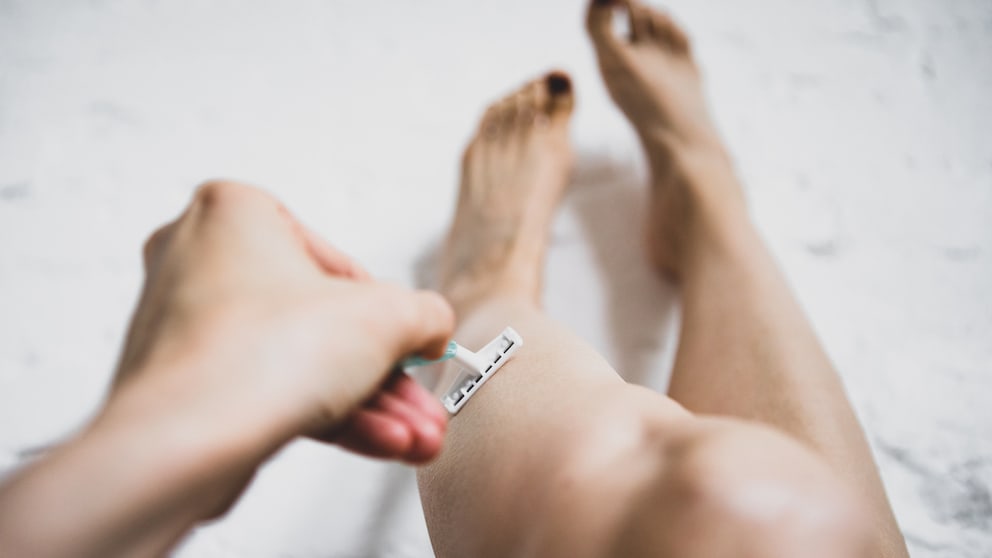April 9, 2025, 12:31 pm | Read time: 4 minutes
Ingrown hairs are itchy, can become painfully inflamed, and appear as red spots on the skin. In short, they are simply annoying. But what actually causes this beauty problem and — more importantly — what helps with ingrown hairs? STYLEBOOK explains the causes and gives tips on prevention.
Overview
How Do Ingrown Hairs Develop?
Ingrown hairs are hairs that grow under the skin instead of out of it. People with curly and thick hair are particularly affected — they curl more quickly, are more stubborn, and, therefore, grow back into the skin more easily or do not grow out of it at all.
In addition to the hair structure, the way the hair is handled is also crucial. Ingrown hairs usually occur in areas where hairs are regularly removed with a razor or epilator. This often affects the area under the armpits, the legs, and the intimate zone. Shaving creates a sharper edge on the hair, which causes it to grow back in the wrong direction. In addition, the hair in the intimate area and under the armpits is thicker and curlier, which makes it even easier for hair to grow into the skin. Dead skin flakes can also be a reason for ingrown hair: pores become blocked, and the hair grows in a different direction as a result. Clothing that is too tight can also be an aggravating factor.
Which Parts of the Body Are Particularly Affected?
Some areas of skin are particularly sensitive and, therefore, more susceptible to ingrown hairs. In the bikini area, for example, the skin is very soft and can therefore be damaged more easily by fine hairs. The skin under the armpits is also soft and elastic. The constant movement of the shoulder joint can cause the individual hairs to grow in instead of being straight. The skin on the legs is also sensitive. Although it is much firmer here, rubbing against tight clothing can influence the direction of hair growth.
How Can You Prevent Ingrown Hairs?
Step 1: Prepare Your Skin Properly
As a general rule, you should only shave again once all ingrown hairs have been removed and the skin is smooth and free of inflammation. Especially in the intimate area, where the skin is particularly sensitive, you should allow it to rest and take care of it after shaving to avoid ingrown hairs. If you don’t want to do without shaving, a hot bath can open the pores in advance. In addition, exfoliation prevents the pores from clogging.
Caution: Always exfoliate before and never immediately after shaving! Otherwise, it can put additional strain on irritated skin and, in the worst case, cause inflammation.
Step 2: Gentle Hair Removal
The right tools are half the battle when it comes to hair removal. Use a high-quality razor or epilator to prevent ingrown hairs. Also, make sure that the blades are sharp. Also, do not shave your skin when it is dry, but always moisturize it. The hair should then be removed in the direction of growth. It is best to use products that soften the hair, i.e., shaving gel or foam, every time you shave.
Step 3: Extra Care After Hair Removal
After exfoliating and shaving, it is essential to moisturize the skin with a mild moisturizer. As the skin is particularly irritated after hair removal, it is important to cool and care for it. Use a soothing care product that is quickly absorbed and non-sticky. This will prevent unsightly friction.

The Best Pistachio Perfumes for Every Budget

Lola Weippert: “I Am Afraid When I Leave My house”

Hyaluronic Acid Against Wrinkles? Application, Effect, Risks
What to Do About Ingrown Hairs?
You can recognize an ingrown hair by small red spots and bumps, which can often be itchy and painful. If the hair is already clearly inflamed, it is better to seek expert advice. An unprofessional removal attempt can otherwise result in inflammation, abscesses, or scars.
If the skin is not yet inflamed, however, you can carefully try to loosen and remove the hair. To do this, first place a warm washcloth on the affected area and allow the heat to work for a few minutes. This soothes the skin and helps to open the pores. Ideally, this allows the hair to find its way out. Exfoliation can also help to loosen skin flakes and calluses. The ingrown hair can then be carefully removed with sterile tweezers. Disinfect the area thoroughly afterward.

